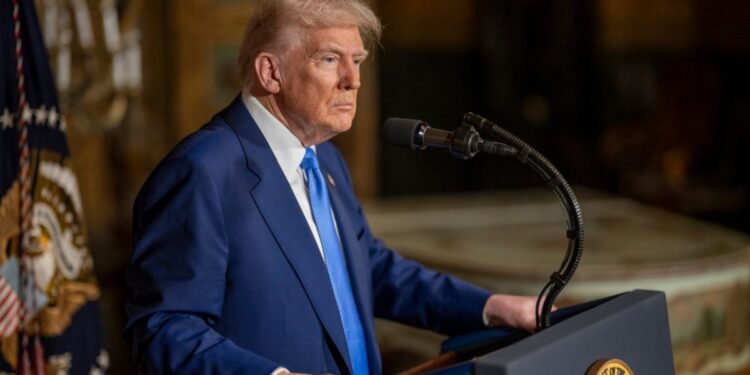On Tuesday, President Trump signed an executive order on in vitro fertilization. Despite the executive order’s claims that it’s “expanding access” to the procedure, it does not actually do that. Instead, the order directs the assistant to the president for domestic policy to submit to Trump, within 90 days, “a list of policy recommendations on protecting IVF access and aggressively reducing out-of-pocket and health plan costs for IVF treatment.”
This is far less than Trump’s campaign promise to force the government or private insurers to fund IVF, which one estimate says could cost around $8 billion, based on an average cost of about $20,000 per cycle.
IVF describes a process in which an egg and sperm are combined in a laboratory setting to create an embryo, which is then transferred to a person’s uterus so they can carry the pregnancy. It’s often used for people struggling with infertility, LGBTQ couples, and single parents.
As the executive order notes, IVF is incredibly expensive. While costs vary, the price of a single cycle ranges from $12,000 to $25,000, the White House says. According to RESOLVE: The National Infertility Association, a nonprofit organization that advocates for expanding IVF access, only a handful of states require insurance companies to cover IVF and fertility preservation in their plans.
Some reproductive rights advocates are calling the order a meaningless attempt at messaging that does not actually do anything to bring down costs or expand availability.
“Don’t be fooled by Trump and Republicans pretending to care about protecting IVF,” said Mini Timmaraju, CEO of the abortion rights group Reproductive Freedom for All. Timmaraju noted congressional Republicans repeatedly blocked a floor vote last year on a bill that would protect IVF access nationwide, as I covered at the time.
The sponsor of that bill, Sen. Tammy Duckworth (D-Ill.), said in a post on X reacting to the executive order news: “Trump’s executive order does nothing to expand access to IVF. But if he’s actually serious about delivering on his campaign promise, he can prove it by calling on Republicans to back my Right to IVF Act. Otherwise, it’s all just lip service from a known liar.” (The White House did not immediately respond to a request for comment on Duckworth’s bill.)
At the same time, anti-abortion advocates are freaking out over Trump’s executive order, with a prominent one alleging Tuesday night, “IVF turns children into a product to be created, sold, and discarded—violating their basic human rights.”
Trump is also, of course, responsible for appointing the three justices to the Supreme Court—Neil Gorsuch, Brett Kavanaugh, and Amy Coney Barrett—who created the conservative supermajority that made it possible to overrule Roe v. Wade in Dobbs v. Jackson Women’s Health Organization, which directly imperiled IVF access. Dobbs was cited in a decision last year by the Alabama Supreme Court that ruled that frozen embryos—which are often discarded in the IVF process—could be considered children under state law. That decision caused nationwide panic as IVF advocates worried that the Dobbs could be used to enact a broader crackdown on IVF. (The state’s Republican governor, Kay Ivey, subsequently signed legislation into law providing doctors and health care professionals civil and criminal “immunity” for providing IVF services.)
Trump responded by promising he would expand IVF access if elected without providing details on how, exactly, this would work. His order basically continues this tradition of vagueness.
Dr. Jamila Perritt, president and CEO of Physicians for Reproductive Health and an ob/gyn based in DC, said the order “does not seem to have any meaningful impact on access to fertility treatments but the intentionally gendered language throughout this order makes me concerned that this will worsen discrimination regarding who can access resources for family building and, by default, determine who is worthy of care.” (The executive order says the administration wants to “make it easier for loving and longing mothers and fathers to have children.”)
Amy Friedrich-Karnik, director of federal policy at the Guttmacher Institute, also said that the abortion rights organization is “deeply concerned that this administration may attempt to limit IVF access to only straight, married couples or otherwise discriminate against LGBTQ+ individuals and single parents.”
The White House did not immediately respond to questions about whether the administration would support measures making IVF more accessible to LGBTQ families—a legitimate question, given that the Trump administration has been doing everything they can to erase transgender people from public life, and given LGBTQ peoples’ frequent reliance on IVF to start families.
Other reactions were more mixed. Sean Tipton, chief advocacy and policy officer for the American Society for Reproductive Medicine (ASRM), said in a statement that the organization was “gratified” to see the executive order, but said the solution is already clear. “There is a fix to this problem: Require health insurance plans to cover IVF for patients who need it,” Tipton said.
But doing that would presumably require an act of Congress (though, as Tipton told me, “in 2025 America, it’s less clear”), and there is no bill that has been currently introduced by any GOP members that would back this.
Tipton pointed to the HOPE with Fertility Service Act, which would require health insurance plans to require appropriate fertility coverage and gained bipartisan support after it was introduced in the House last year, as a piece of model legislation, adding that ASRM hopes it will be reintroduced with bipartisan support in March.
In the meantime, Tipton added, Trump should immediately ensure “that all federal employees, civilian and military, have access to IVF.”
Last September, the Biden administration announced the Federal Employees Health Benefits (FEHB) Program would offer expanded fertility benefits to federal workers and their families, with every state offering at least two plan options for IVF coverage—news that would affect an estimated 8 million people on FEHB plans, according to RESOLVE. But Tipton says that didn’t go far enough, because it did not require every plan to include fertility benefits. “It was good,” Tipton said, “but not nearly as good as what they should’ve done.”
TRICARE, the military health insurance program used by more than 9 million active service members, retirees, and their families, does not cover IVF services (though active duty service members who incur an injury that leads to their infertility may be eligible to access IVF and other fertility benefits at no cost, TRICARE says).
Trump, Tipton said, “can make TRICARE cover it and make every insurance plan available to federal employees include it—he can do that with a stroke of a pen.”







